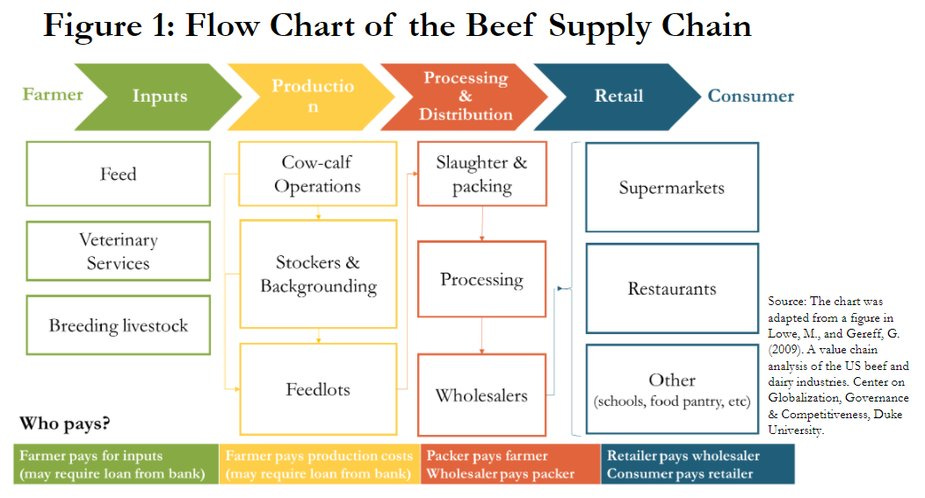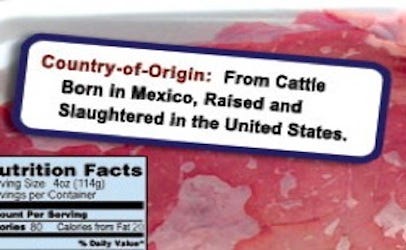Lifting the Dark Curtain of the Beef Industry
85% of the beef you see at the grocery store is controlled by 4 companies. Here is what this means for your health.
Happy Tuesday Mafia. I am currently a cold brew deep so bear with me. This blog is coming in a flurry of inspiration after getting to sit down with Jim Mundorf and record an episode. Jim is an Iowa-based rancher that runs Lonesome Lands, which gives conscious consumers (like yourselves) the unbiased scoop on ranching, beef, and the war for pure-animal protein. We had an amazing conversation with Jim and cannot wait to release the episode to you all.
His insight into the Big 4 Packers is something I cannot stop thinking about. There is so much to understand in regards to the centralization of our Beef supply.
What’s fascinating about our food system is that we normalize things that should not be normalized. We normalize fake foods on the shelves of our grocery stores. We normalize subsidizing farmers to grow massive amounts of corn, wheat, and soy. We normalize being metabolic unhealthy. And we normalize the centralization & monopolization of our beef industry.
We focus on the monopolization of technology & data and have seen a concerted effort to break up tech giants such as Twitter, Google, and Facebook, yet completely overlook similar monopolization that occurs with our own beef supply.
Currently, there are 4 Beef Packers that control 85% of all beef in the grocery store. These packers are:
Cargill
JBS
Tyson
National Beef
These 4 Packers have quietly centralized our Beef supply through aggressive M&A activity over the last few decades. Gone are the days of hyper-localization or knowing the processor that is butchering your meat. Instead, we are at the mercy of a few publicly traded entities that have a fiduciary responsibility to deliver as much value to their shareholders as possible.
To give you some further context, here is the breakdown of our current Beef Supply Chain in the US:
2.04 Million Ranchers (Where cow is raised)
27,000 feed lots (Where cow is fattened up)
5,559 Meat, Beef & Poultry Processing(Where cow is slaughtered)
355 Million Consumers (You, who is eating the Beef)
There is a gigantic discrepancy between the number of ranchers that are raising our beef and the processing centers that are actually butchering the animal. This is what we call a clearly-defined bottleneck. Within those 5,559 processors, The Big 4 rule the roost. They process so many animals and have such a strong foothold that they can break the back of the rancher and overcharge you as the consumer. It is truly a “lose-lose” supply chain.
Have you noticed how the price of steak in the grocery store continues to increase?
Since 1985, the cost of ground beef has increased by over 40%. At the same time, the cost of beef cattle has decreased by 50%. This means that you (the consumer) are getting overcharged and your rancher is getting price-gouged by the Packer.
The Packer makes insane profits per head of cattle. Currently, The Big 4's margin on a choice steer is $1,000 - $1,300 per head of cattle. They process 500 - 600,000 cattle per week. Which gives them a Gross Margin of $2.6 Billion per month. Billion. Yes, with a B.
This is what happens when there is vast centralization over the food you are eating. I can promise you that these companies do not care about your health or the health of the animal you are consuming.
In 2021, these Big 4 Packers made $13B in pure profit. Meanwhile, the rancher who is actually raising the cow is making $100 per cow on average. ($250 per cow is considered very good). Contrast this to Packers, who make $1,000 - $1,3000 per cow.
To take it a step further, In 2016, the Country of Origin Labeling Act (COOL) was repealed. COOL required retailers to disclose where their food comes from. For example, if the beef in your Whole Foods was raised in Brazil but slaughtered in the US, it needed to disclose that. The repeal of this act allows packers to import cheap foreign beef carcasses and label them as a product of the USA.
I can promise you that these packers do not care about providing your family with pure animal protein like your local rancher does. Take a look into some of their investments and portfolio companies and you will see what I mean:
JBS, Tyson, Cargill, and Smithfield are heavily leveraged into the “fake meat” space. Yes, the same companies that are providing you with animal protein are also profiting off of fake-meat alternatives that leverage mono-crop agriculture, bioengineered foods, and are fundamentally going against the laws of nature.
Incentives drive behavior.
I want you to keep this blog post in mind the next time you are securing meat at the grocery store. The cost is not just the $6 you pay for ground beef at the grocery store vs. the $9 beef from your local farmer.
The true cost is the corruption, greed, and manipulation involved to get you that $6 beef. The cost is supporting a hyper-centralized beef supply chain that does not care about the treatment of the animal you are eating or you as the consumer. If they did, they would not be making investments in the fake meat space.
Every time you are securing beef for your family you have a choice to incentivize the future you want. You have more power than you even know. When you continue to buy your beef from the grocery store, you allowing these companies to continue to operate in the same malicious way that they always have.
Step out of your comfort zone and make a change for your family and your rancher. Utilize websites like Eat Wild to connect with your local farmer. Go out there and shake their hand. Ask them questions about how they raise their beef. Give them your hard earned money in exchange for the most nutrient-dense protein you can get your hands on. Vote for the system you wish to see.
With love,
Sollozzo 🥩❤️








Great post!
There is no stronger vote than that of one’s dollar. Very good blog.